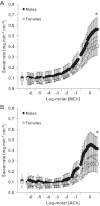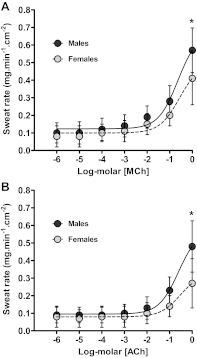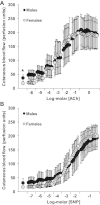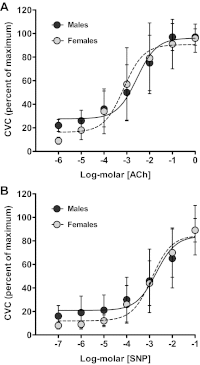Sex differences in postsynaptic sweating and cutaneous vasodilation
- PMID: 23154992
- PMCID: PMC3568872
- DOI: 10.1152/japplphysiol.00877.2012
Sex differences in postsynaptic sweating and cutaneous vasodilation
Abstract
The current study aimed to determine whether a peripheral modulation of sweating contributes to the lower sudomotor thermosensitivity previously observed in females during exercise. We examined dose-response relationships in 12 males and 12 females to incremental doses of acetylcholine (ACh) and methylcholine (MCh) for sweating (ventilated capsule), as well as to ACh and sodium nitroprusside (SNP) for cutaneous vasodilation (laser-Doppler). All drugs were infused using intradermal microdialysis. On a separate day, potential sex differences in the onset threshold and/or thermosensitivity of heat loss responses were assessed during progressive increases in mean body temperature elicited by passive heating. Increases in sweating as a function of increasing concentration of ACh (P = 0.008) and MCh (P = 0.046) significantly differed between males and females. Although the concentration eliciting 50% of the maximal sweating response did not differ between sexes for either agonist (P > 0.1), maximum values were lower in females in response to ACh (0.34 ± 0.12 vs. 0.59 ± 0.19 mg·min(-1)·cm(-2), P = 0.04) and MCh (0.48 ± 0.12 vs. 0.78 ± 0.26 mg·min(-1)·cm(-2), P = 0.05). This observation was paralleled by a lower thermosensitivity of sudomotor activity in females during passive heating (1.29 ± 0.34 vs. 1.83 ± 0.33 mg·min(-1)·cm(-2)·°C(-1), P = 0.03), with no significant differences in the change in mean body temperature at which onset of sweating occurred (0.85 ± 0.19 vs. 0.67 ± 0.13°C, P = 0.10). No sex differences in cutaneous vasodilation were observed in response to ACh and SNP, as well as during passive heating (all P > 0.1). These findings provide direct evidence for a peripheral modulation of sudomotor activity in females. In contrast, sex does not modulate cutaneous vasodilation.
Figures






Similar articles
-
Topical anaesthesia does not affect cutaneous vasomotor or sudomotor responses in human skin.Auton Autacoid Pharmacol. 2013 Oct;33(3-4):25-33. doi: 10.1111/aap.12007. Epub 2013 May 13. Auton Autacoid Pharmacol. 2013. PMID: 23663206 Clinical Trial.
-
Nonuniform, age-related decrements in regional sweating and skin blood flow.Am J Physiol Regul Integr Comp Physiol. 2013 Oct 15;305(8):R877-85. doi: 10.1152/ajpregu.00290.2013. Epub 2013 Aug 7. Am J Physiol Regul Integr Comp Physiol. 2013. PMID: 23926135 Free PMC article.
-
Nicotinic receptors modulate skin perfusion during normothermia, and have a limited role in skin vasodilatation and sweating during hyperthermia.Exp Physiol. 2019 Dec;104(12):1808-1818. doi: 10.1113/EP088072. Epub 2019 Nov 13. Exp Physiol. 2019. PMID: 31608521
-
Responses to hyperthermia. Optimizing heat dissipation by convection and evaporation: Neural control of skin blood flow and sweating in humans.Auton Neurosci. 2016 Apr;196:25-36. doi: 10.1016/j.autneu.2016.01.002. Epub 2016 Jan 21. Auton Neurosci. 2016. PMID: 26830064 Review.
-
Influence of sex and biological maturation on the sudomotor response to exercise-heat stress: are girls disadvantaged?Am J Physiol Regul Integr Comp Physiol. 2022 Aug 1;323(2):R161-R168. doi: 10.1152/ajpregu.00328.2021. Epub 2022 Jun 7. Am J Physiol Regul Integr Comp Physiol. 2022. PMID: 35670483 Review.
Cited by
-
Effects of biological sex and oral contraceptive pill use on cutaneous microvascular endothelial function and nitric oxide-dependent vasodilation in humans.J Appl Physiol (1985). 2023 Apr 1;134(4):858-867. doi: 10.1152/japplphysiol.00586.2022. Epub 2023 Mar 2. J Appl Physiol (1985). 2023. PMID: 36861674 Free PMC article.
-
Age-related differences in postsynaptic increases in sweating and skin blood flow postexercise.Physiol Rep. 2014 Jul 16;2(7):e12078. doi: 10.14814/phy2.12078. Physiol Rep. 2014. PMID: 25347861 Free PMC article.
-
Exploring the mechanisms underpinning sweating: the development of a specialized ventilated capsule for use with intradermal microdialysis.Physiol Rep. 2016 Mar;4(6):e12738. doi: 10.14814/phy2.12738. Epub 2016 Mar 31. Physiol Rep. 2016. PMID: 27033452 Free PMC article. Clinical Trial.
-
Sex Differences in VO2max and the Impact on Endurance-Exercise Performance.Int J Environ Res Public Health. 2022 Apr 19;19(9):4946. doi: 10.3390/ijerph19094946. Int J Environ Res Public Health. 2022. PMID: 35564339 Free PMC article. Review.
-
Fundamental Concepts of Human Thermoregulation and Adaptation to Heat: A Review in the Context of Global Warming.Int J Environ Res Public Health. 2020 Oct 24;17(21):7795. doi: 10.3390/ijerph17217795. Int J Environ Res Public Health. 2020. PMID: 33114437 Free PMC article. Review.
References
-
- Armstrong CG, Kenney WL. Effects of age and acclimation on responses to passive heat exposure. J Appl Physiol 75: 2162–2167, 1993 - PubMed
-
- Buono MJ, Sjoholm NT. Effect of physical training on peripheral sweat production. J Appl Physiol 65: 811–814, 1988 - PubMed
-
- Buono MJ, White CS, Connolly KP. Cholinergic sensitivity of the eccrine sweat gland in trained and untrained men. J Dermatol Sci 4: 33–37, 1992 - PubMed
-
- Canadian Society for Exercise Physiology Determination of aerobic power. In: Certified Fitness Appraiser Resource Manual. Gloucester, Ontario, Canada: CSEP, 1986, chapt. II, p. 1–32
-
- Cheuvront SN, Bearden SE, Kenefick RW, Ely BR, Degroot DW, Sawka MN, Montain SJ. A simple and valid method to determine thermoregulatory sweating threshold and sensitivity. J Appl Physiol 107: 69–75, 2009 - PubMed
Publication types
MeSH terms
Substances
Grants and funding
LinkOut - more resources
Full Text Sources
Other Literature Sources
Miscellaneous

